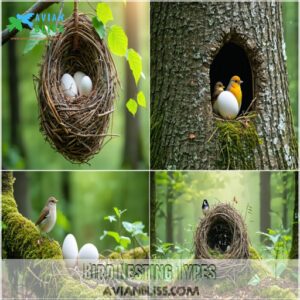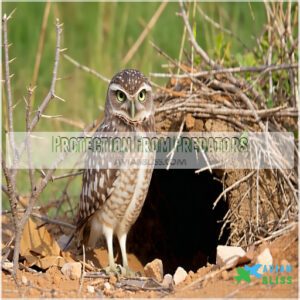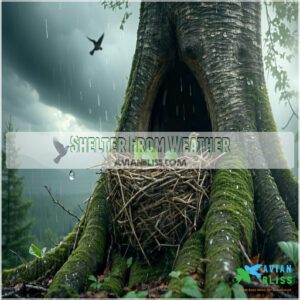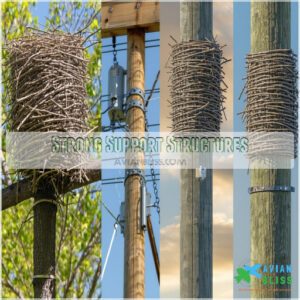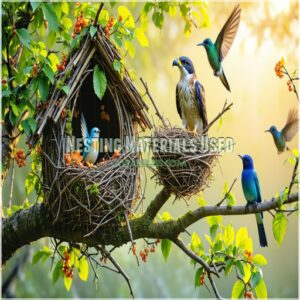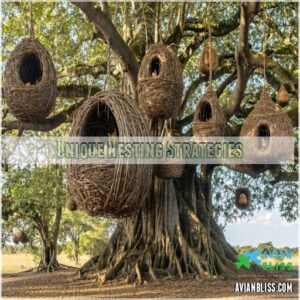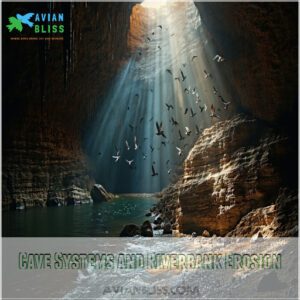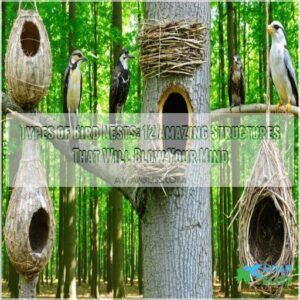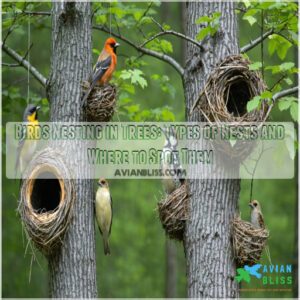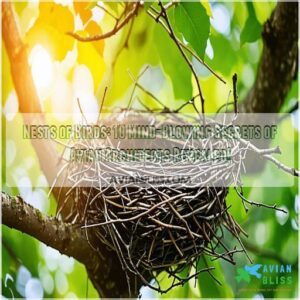This site is supported by our readers. We may earn a commission, at no cost to you, if you purchase through links.

The main types of bird nesting sites include cup nests woven from plant fibers, cavity nests tucked into tree hollows, platform nests built from sturdy sticks, and ground nests camouflaged in plain sight.
From tiny hummingbird homes using spider silk to massive eagle fortresses atop skyscrapers, each species has evolved unique building strategies.
Natural cavities offer the best protection, with a 65% higher survival rate than exposed spots, and some clever builders, like burrowing owls, even create decoy nests to outsmart predators, showcasing their unique building strategies.
Table Of Contents
- Key Takeaways
- Bird Nesting Types
- Nesting Site Selection
- Nesting Materials Used
- Unique Nesting Strategies
- Nesting Locations and Habitats
- Frequently Asked Questions (FAQs)
- What are the 5 types of bird nests?
- Why is bird’s nest illegal?
- What is a bird breeding area called?
- What are the different places where birds live?
- How long do birds typically use the same nest?
- Do birds repair and maintain nests between seasons?
- What time of year do different birds build nests?
- How do climate changes affect bird nesting patterns?
- Conclusion
Key Takeaways
- You’ll find four main types of bird nests: cup nests woven from plant fibers, cavity nests in tree hollows, platform nests built from sticks, and ground nests camouflaged in natural surroundings – each evolved to provide specific protection and survival advantages.
- You’ll see birds carefully select nesting sites based on three key factors: protection from predators (with cavity nests showing 65% higher survival rates), shelter from harsh weather, and proximity to food and water sources.
- You’ll notice birds use an impressive range of materials in their construction, from traditional twigs and mud to spider silk for flexibility, and even urban debris in city environments – demonstrating remarkable adaptability to different habitats.
- You’ll discover unique nesting strategies across species, from burrowing owls that create decoy nests to sociable weaverbirds that build massive communal structures housing up to 100 pairs, showing how different birds have evolved specialized approaches to ensure their survival.
Bird Nesting Types
You’ll discover that birds construct their nests in a variety of ways, from the tiny quarter-sized homes of hummingbirds to the massive 4,400-pound structures built by bald eagles.
When you look closely at these architectural wonders, you’ll find four main types of nests.
These nests can be categorized into: cups woven from plant fibers, sheltered cavities in trees, flat platforms made of sticks, and simple scrapes on the ground.
Cup Nests and Features
A cup nest is nature’s perfect cradle, shaped like a cozy teacup where birds raise their young.
You’ll find these architectural marvels crafted with incredible precision, varying in size from tiny hummingbird homes to larger robin dwellings.
Here’s what makes cup nests special:
- They’re woven with spider silk and plant fibers for flexibility
- The egg chamber curves inward to prevent rolling
- Soft nest linings include feathers and fur
- Different species create unique cup depths for best protection
The construction of cup nests often involves a bird cup nest design, which can be studied in products featuring bird cup nest materials, showcasing nature’s perfect cradle, with incredible precision, and architectural marvels that provide best protection.
Cavity Nests and Tree Selection
While many birds craft intricate nests from scratch, cavity-nesting birds prefer ready-made homes in tree hollows.
You’ll find woodpecker nests and natural tree cavities offering cozy shelters that protect birds from harsh weather and predators.
The nest entrance size and cavity depth vary by species, with some birds selecting cavities in specific tree species that suit their needs perfectly.
Understanding cavity nesting behaviors is essential for appreciating the complexity of bird nesting sites.
Platform Nests and Construction
While cavity nesters prefer enclosed spaces, platform nests showcase a different approach to bird architecture.
You’ll find these elevated nests perched atop sturdy branches or human-made structures, where birds create flat, stable foundations using carefully selected materials.
- Eagles construct massive platforms reaching up to 4,400 pounds
- Ospreys add new materials yearly, creating distinctive layer-cake designs
- Hawks weave intricate stick patterns for structural integrity
- Herons arrange flexible twigs in precise geometric patterns
- Great horned owls often repurpose existing platform nests to create new homes, using carefully selected materials and showcasing their ability to adapt and reuse, which is a key aspect of their bird architecture.
Ground Nests and Camouflage
While platform nests dominate the treetops, nature’s ground-level architects take a different approach.
You’ll find these master camouflage artists, like killdeer and nightjars, crafting subtle depressions in the earth.
Their nests blend seamlessly with surrounding terrain through clever camouflage techniques.
The eggs themselves showcase nature’s artistry, with speckled patterns perfectly matching sandy granules.
It’s a remarkable display of egg coloration that helps guarantee their survival.
Nesting Site Selection
You’ll find that birds are surprisingly picky about their real estate choices, carefully selecting sites that offer protection from predators and harsh weather while staying close to food sources.
When you’re watching birds scout for nesting spots, you’ll notice they check for strong support structures, like sturdy tree branches or protected ledges, that can safely hold their precious eggs and chicks.
Protection From Predators
Birds have evolved remarkable strategies for nest protection, turning their homes into natural fortresses against predators.
You’ll find these clever architects selecting sites that maximize predator avoidance while maintaining clear escape routes. Natural cavity nests show 65% higher survival rates than exposed locations, proving that location truly matters in the bird world.
- Burrowing owls scatter debris near their burrow entrances, creating nature’s version of a home security system
- Bank swallows craft tunnel-like nests in steep riverbanks, complete with emergency exits
- Ground-nesting birds choose elevated spots with panoramic views of approaching threats
- Cavity-nesters pick holes 5-20 feet up, keeping eggs safe from ground predators
- Platform nesters build on outer branches, using thorny twigs as natural barbed wire
Shelter From Weather
While seeking protection from harsh elements, tree cavity nests provide excellent Weather Protection during storms.
You’ll find that ledge nesting areas, tucked beneath overhanging rocks, act as natural Rain Guards.
Smart Climate Adaptation leads birds to choose dense foliage or rock face nests that block wind.
Storm Shelters like cliff nesting sites shield eggs and chicks from rain, while Wind Blocks protect vulnerable nestlings from gusts.
Birds often prioritize nesting sites based on their natural nesting behavior patterns to provide the best chance of survival for their offspring.
Proximity to Food and Water
While nesting locations must shield from harsh elements, proximity to food sources and water access plays an equally essential role.
You’ll notice that most successful nest locations sit within easy reach of reliable food and water.
This smart placement lets parent birds zip back and forth during feeding time, conserving energy while ensuring their chicks get proper nourishment – a strategy you’ll see everywhere from wetland edges to forest clearings.
Strong Support Structures
Beyond finding food-rich territories, understanding nest frames and beam supports can make or break a bird’s home.
You’ll notice tree branch nests often rely on multiple support points, while power pole nests need sturdy column designs.
Foundation types vary from interwoven twigs on fence post nests to specialized anchoring on roof structures.
Column nesting sites and roof nesting sites demand extra reinforcement against wind and weather, which is crucial for the bird’s home.
Nesting Materials Used
You’ll find birds using an incredible variety of materials to construct their homes, from traditional twigs and mud to surprising items like spider silk and urban debris.
Whether you’re watching a hummingbird weave spider webs into a tiny nest or an eagle hauling massive sticks to its platform, you’ll discover that each species has perfected its own unique building techniques.
Twigs and Mud Construction
You’ll be amazed by the intricate nest architecture that combines twigs and mud into sturdy homes.
These natural nesting materials showcase remarkable bird engineering, where mud acts like cement between carefully gathered twigs. Birds often incorporate safe nesting materials like dry grass and feathers for added insulation and comfort.
Here’s how birds create these masterpieces:
- They collect fresh mud after rain for ideal consistency
- Each twig is tested for strength before placement
- Multiple layers are built up gradually, allowing each to dry, which is a testament to their remarkable bird engineering and use of natural nesting materials like mud and twigs to create a sturdy home.
Spider Silk and Plant Fibers
You’ll find spider webs in nearly every hummingbird nest, where these tiny architects use silk production for binding plant fibers together.
Web construction creates flexible walls that stretch as chicks grow.
The nest architecture often includes moss and lichen camouflage woven into a cozy cup.
Material selection varies by species – orioles prefer long, stringy fibers for their hanging nests, while ruby-throated hummingbirds incorporate delicate flower petals.
Urban Debris and Human-Made Items
The resourceful nature of birds in urban environments showcases their remarkable adaptability.
Research reveals 176 bird species using human-made materials for nest construction.
You’ll spot them transforming everyday items into cozy homes, proving that one bird’s trash is another bird’s treasure.
- Telephone wires become perfect perches for intricate nests woven with discarded string
- Power lines host nests decorated with colorful plastic strips
- Rooftops transform into penthouse suites lined with newspaper bits
- Windowsills serve as platforms for nests made from recycled materials
- Bridge beams shelter nests crafted from urban waste and manmade objects, demonstrating their ability to reuse and recycle materials in creative ways, showcasing their remarkable ability to thrive in human-dominated landscapes.
Soft Materials and Feathers
The delicate art of nest lining reveals nature’s coziest secrets.
You’ll find birds collecting feathers, plant down, and fuzzy textures to create insulated sanctuaries for their eggs.
They’ll weave soft fibers and animal wool into intricate patterns, ensuring perfect temperature control.
Watch as they gather plant fibers from cottonwood trees or cattails, transforming these materials into plush nest linings that rival luxury bedding.
Birds often utilize specific nesting material types to construct their nests, showcasing their adaptability and resourcefulness.
Unique Nesting Strategies
You’ll be amazed by the clever ways birds protect and build their homes, from burrowing owls that scatter debris near their burrow entrances to confuse predators to sociable weaverbirds that create massive communal nests housing over 100 pairs.
These unique strategies show how birds have adapted to survive, whether they’re carving tunnel-like nests into muddy cliffs or taking over other birds’ homes through nest parasitism.
They demonstrate remarkable adaptability, showcasing how different species employ distinct methods to ensure their survival, highlighting the clever ways birds protect and build their homes.
Burrowing Owls and Predator Deterrents
While many birds rely on traditional nesting materials, burrowing owls take a different approach to nest protection.
These ground nesting birds have developed clever burrow defense strategies that’ll make you smile.
- They scatter animal droppings near their burrow entrance as a predator decoy
- Their tunnel security includes strategic placement of shiny objects
- Owl camouflage helps them blend perfectly with their surroundings
- These nest guardians maintain multiple entrance holes
- They create debris barriers using grass and twigs
You’ll find these remarkable birds repurposing abandoned prairie dog tunnels or digging their own homes, transforming simple burrows into fortress-like shelters against predator risks.
Sociable Weaverbirds and Communal Nests
While burrowing owls prefer solitary dwellings, sociable weaverbirds create nature’s largest apartment complexes.
You’ll find these remarkable birds building massive communal nests that house up to 100 breeding pairs.
Their intricate colony nests feature multiple chambers, each precisely woven with grass stems and twigs, and these feathered architects maintain their social bonding through shared nest architecture, working together to expand their structure year after year, showcasing their remarkable communal nests.
Bank Swallows and Tunnel-Like Nests
Like nature’s skilled architects, bank swallows carve intricate tunnel-like nests into steep riverbanks and cliffs.
You’ll find these remarkable cavity nests extending up to 4 feet deep, carefully positioned to protect their young from predators and weather. Through precise nest excavation techniques, these birds create complex burrow systems that showcase their impressive adaptation to bank erosion.
- Watch in awe as hundreds of swallows swoop and dive around their colony homes
- Marvel at their perfectly round tunnel entrances, each precisely 2 inches wide
- Feel the cool, earthy safety of their carefully engineered burrow systems
- Witness the bustling social life as neighbors chat between adjacent tunnels
- Experience the thrill of discovering nature’s hidden apartment complexes in ordinary riverbanks
These intricate tunnel-like nests are a testament to the swallows’ remarkable engineering skills, and their complex burrow systems provide a safe haven for their young. The precise nest excavation techniques used by these birds are a key factor in their ability to thrive in challenging environments, and their carefully engineered homes are a wonder to behold. The swallows’ ability to adapt to bank erosion is also noteworthy, and their hidden apartment complexes are a fascinating discovery.
Parasitic Breeding and Nest Takeovers
While some birds construct their own homes, others take a sneakier approach through brood parasitism and nest takeovers.
These parasitic breeding specialists have evolved shorter incubation periods, freeing up time for host manipulation. Brood parasites often employ avian brood parasitism strategies to maximize their reproductive success.
You’ll find species like cuckoos practicing nest hijacking, laying eggs that perfectly mimic their host’s through egg mimicry.
Some Tree Swallows even practice coevolution strategies, forcefully claiming occupied nests and building on top of existing eggs.
Nesting Locations and Habitats
You’ll find birds building their homes in surprising places, from urban skyscrapers and bridges that serve as vertical sanctuaries to natural hideaways in tree canopies and coastal cliffs.
Whether you’re exploring cave systems or watching city streets, you’ll discover how these resourceful creatures transform nearly any environment into their perfect nesting grounds.
Urban Nesting Sites and Skyscrapers
While wild species traditionally build nests in natural settings, skyscrapers now serve as vertical sanctuaries for city birds seeking urban roosts.
Birds face urban habitat challenges, adapting to city life.
You’ll spot peregrine falcons and pigeons claiming ornamental ledges, while barn owls find cozy spots in rooftop engineering spaces.
These urban nesting sites offer surprising advantages – higher nests typically see greater success rates, though some species adapt by choosing lower spots as cities grow denser, presenting a unique urban roosts scenario with city life adaptations.
Tree Canopy Habitats and Natural Protection
The majestic tree canopy provides nature’s perfect apartment complex for our feathered friends.
You’ll find intricate nests tucked away in these leafy sanctuaries, where branch support and leaf shelter create ideal nesting conditions.
Tree nesting birds benefit from multiple canopy layers that offer natural protection from predators and harsh weather.
- Dense foliage conceals nests from hawks and other aerial predators
- Multiple trunk levels provide diverse nesting opportunities
- Intertwined branches offer stable support for heavier nests
- Overlapping leaves create natural umbrellas during storms
- Varying canopy heights allow for species-specific nest placement preferences
The combination of these features makes the tree canopy an ideal location for birds to build their nests, providing them with natural protection and stable support.
Coastal Cliff Dwellings and Isolation
Towering coastal cliffs provide nature’s perfect isolation for seabird colonies.
You’ll find these rocky coastal cliffs teeming with life, as countless birds make their homes on narrow ledges.
| Species | Nesting Style | Ledge Protection | Colony Size |
|---|---|---|---|
| Common Murres | Bare rock | Pointy eggs | 10,000+ pairs |
| Peregrine Falcons | Stick nests | Deep crevices | 1-2 pairs |
| Black-legged Kittiwakes | Mud platforms | Steep walls | 1,000+ pairs |
| Northern Gannets | Seaweed mounds | Wide ledges | 5,000+ pairs |
These cliffside nesting spots offer excellent protection from land predators while providing easy access to marine hunting grounds.
Cave Systems and Riverbank Erosion
Beyond the rocky coastal cliffs, nature carves out unique sanctuaries in cave systems and eroded riverbanks.
You’ll find Cave Swallows making themselves at home in both natural caverns and human structures like culverts and bridges.
These adaptable birds have even colonized ancient Mayan temples, and look for cavity-nesters like tits and redstarts in tree hollows, where they seek round entrance holes, often repurposing old woodpecker homes.
Frequently Asked Questions (FAQs)
What are the 5 types of bird nests?
You’ll find birds create five distinct nest types: cups built with grass and mud, platforms made of sticks, cavities in trees, ground scrapes in dirt, and hanging pouches woven from plant fibers.
These nest types can be broadly categorized, but the variety shows the diverse ways birds adapt to their environments.
Why is bird’s nest illegal?
Bird’s nests aren’t typically illegal, but harvesting edible swiftlet nests without permits is banned in many countries.
You’ll need proper documentation to collect, trade, or export these valuable nests used in cuisine.
What is a bird breeding area called?
Like a bustling city’s neighborhoods, a bird breeding area is called a rookery or nesting colony.
You’ll find these special spots where multiple birds build nests close together to raise their young.
What are the different places where birds live?
You’ll discover birds in diverse habitats – from dense forests to urban skyscrapers.
They’ll nest in tree cavities, build homes on coastal cliffs, burrow underground, and create floating platforms on water.
How long do birds typically use the same nest?
You’ll notice that most birds build fresh nests each spring.
But eagles and larger raptors often reuse and expand their nests for decades, adding new materials while maintaining their original foundation.
Do birds repair and maintain nests between seasons?
You’ll find that most birds do repair and maintain their nests between seasons, adding fresh materials and reinforcing weak spots.
Eagles and larger species often expand their nests yearly for continued use.
What time of year do different birds build nests?
When spring unfolds its gentle wings, you’ll see most birds building nests between March and July.
However, some species like bald eagles start construction as early as January in warmer regions.
How do climate changes affect bird nesting patterns?
You’ll notice warmer temperatures cause birds to nest earlier.
While extreme weather disrupts nesting locations and food sources.
Climate shifts also affect migration timing and force birds to seek new nesting grounds.
Conclusion
Like Leonardo da Vinci’s ingenious designs, birds are master architects crafting diverse types of bird nesting sites.
You’ll discover they’re skilled builders, adapting their homes to meet unique challenges. From cup nests woven with spider silk to cavity nests in ancient trees, each design showcases nature’s innovation.
Whether you’re spotting platform nests atop skyscrapers or ground nests hidden in plain sight, you’re witnessing evolution’s blueprint for survival.
These remarkable builders continue to inspire and amaze with their resourceful construction methods.
- https://www.feathersnapcam.com/blog/post/exploring-the-diverse-nests-of-different-bird-species
- https://ecosystems.psu.edu/research/centers/private-forests/news/birds-need-nesting-sites-you-can-help
- https://wildbirdstore.com/2023/04/19/nesting-season-and-types-of-nests/
- https://www.birdfy.com/blogs/blogs/10-different-bird-nests-and-how-to-spot-them?srsltid=AfmBOoooBVLsMZVBkSaZ7JTNlMjPvtgQY7NH55DNGlyHmqbNuaAOZAtT
- https://www.yorkccd.org/wp-content/uploads/2022/10/Bird-Nests.pdf

